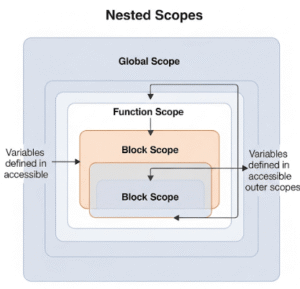JavaScript Variable Scope: Understanding Where Variables Live
The scope of variables in JavaScript defines the accessibility of variables, functions, and objects in some particular part of your code during runtime. Essentially, scope determines where a variable is visible and can be referenced. Grasping JavaScript variable scope is fundamental for preventing unintended variable modifications, avoiding naming conflicts, and writing cleaner, more predictable code. This concept dictates which parts of your program can “see” or access a particular variable, profoundly influencing how your scripts behave.
What is Scope in JavaScript?
In JavaScript, scope is the context in which values and expressions are “visible” or can be referenced. If a variable is not “in scope,” it cannot be accessed. There are distinct types of JavaScript variable scope, each governing how variables are defined and accessed within different parts of your program. Understanding these different scopes is critical for managing data flow and avoiding common programming errors, particularly when working with larger applications.
Global Scope
A variable declared in the global scope, or outside of any function or block, is accessible from anywhere in your JavaScript code. This means it can be accessed from within any function, any block, or any other part of the script. Global JavaScript variables are convenient because they are universally available; however, they can also lead to “global namespace pollution,” where too many global variables might conflict with each other or with third-party libraries, making debugging more challenging.
Here’s an example demonstrating global scope:
var globalMessage = "I am a global variable."; // Declared in global scope
function displayGlobalMessage() {
console.log(globalMessage); // Accessible inside the function
}
displayGlobalMessage(); // Output: I am a global variable.
console.log(globalMessage); // Accessible outside the function too
In this scenario, globalMessage is a JavaScript variable residing in the global scope.
Function Scope (Local Scope)
Variables declared inside a function are said to be in function scope, also known as local scope. These variables are only accessible from within the function where they are defined. They cannot be accessed from outside that function. This isolation is highly beneficial as it prevents variables used in one function from interfering with variables of the same name in other functions, thereby promoting modular and robust code.
Consider this illustration of function scope for JavaScript variables:
function greetUser() {
var greeting = "Hello from function scope!"; // Declared in function scope
console.log(greeting); // Accessible inside the function
}
greetUser(); // Output: Hello from function scope!
// console.log(greeting); // This would cause an error: greeting is not defined
Here, greeting is a local JavaScript variable, confined to the greetUser function.
Block Scope with let and const
Prior to ES6 (ECMAScript 2015), JavaScript primarily had only global and function scope for variables declared with var. However, ES6 introduced two new keywords for declaring variables: let and const. These keywords provide block scope, which means variables declared with let or const are limited to the block (curly braces {}) in which they are defined. This includes if blocks, for loops, while loops, and other code blocks. Block scope significantly improves control over variable visibility and helps reduce potential errors associated with variable hoisting and re-declaration.
let Keyword
Variables declared with let have block scope. They can be re-assigned but cannot be re-declared within the same scope.
if (true) {
let blockVar = "I am block-scoped with let.";
console.log(blockVar); // Accessible inside this block
}
// console.log(blockVar); // Error: blockVar is not defined (outside the block)
const Keyword
Variables declared with const also have block scope. The key difference is that const variables must be initialized at the time of declaration and their value cannot be re-assigned later. They are constant, providing immutability for primitive values and preventing re-assignment for objects/arrays.
const PI = 3.14159;
// PI = 3.0; // Error: Assignment to constant variable.
if (true) {
const MY_CONSTANT = "This is a constant in a block.";
console.log(MY_CONSTANT); // Accessible inside this block
}
// console.log(MY_CONSTANT); // Error: MY_CONSTANT is not defined (outside the block)
Using let and const promotes better coding practices by offering finer-grained control over JavaScript variable scope and immutability, thereby reducing bugs and improving code readability.
Conclusion: Importance of JavaScript Variable Scope
In conclusion, understanding the different types of JavaScript variable scope – global, function, and block – is crucial for writing efficient, error-free, and maintainable JavaScript code. While var provides function-level scope, the introduction of let and const has empowered developers with block-level scope, enabling more precise control over variable accessibility and behavior. By thoughtfully managing the scope of your variables, you can prevent naming conflicts, improve code organization, and enhance the overall reliability of your web applications.
